Articles and News
WHAT LUXURY JEWELERS CAN LEARN FROM APPLE | November 20, 2012 (0 comments)
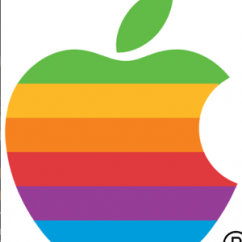
Merrick, NY—When Apple first introduced the Macintosh in 1984, it forever changed the way people interact with their computers. The Mac’s windows-and-mouse interface obliterated the need to learn code, which encouraged a lot more people to buy a computer. It could have spelled disaster for rival Microsoft (creator of the then-common MS-DOS operating system), had the firm not realized the implications of a graphic interface and figured out how to successfully blend its own strengths in software with Apple’s intuitive system and IBM’s (then) leadership in personal computer hardware. With the launch of Windows, Microsoft became the undisputed leader in software for business, finance, and technology. Apple was largely relegated to creative fields.
It was a classic story: Apple blazed the trail, but Microsoft built the road. It could have meant Apple would remain a niche brand or eventually be acquired by a larger firm—like, say, Microsoft. But today Apple is both the undisputed luxury brand of the technology field and held up as an example of outstanding retailing. How did it do that? And what can luxury jewelers learn from it?
Apple did it two ways: one, by becoming a game-changer (again), and two, by focusing on the experience of using technology, not the technology itself.
What Apple’s success means for you. Just as the Mac did for computing, Apple’s iPod, launched in 2001, revolutionized the way people consume music. And the iPhone, launched in 2007, was more than a consolidation of cell phone, PDA, and MP3 player—it essentially created today's smartphone market, heralding the beginning of what experts call “the post-PC era.”
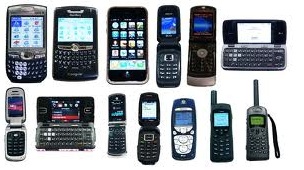
Prior to the iPhone (below left front), mobile phones and PDA's sported a variety of designs, as above. But all new smartphones, regardless of manufacturer, follow a similar design to the iPhone, below.
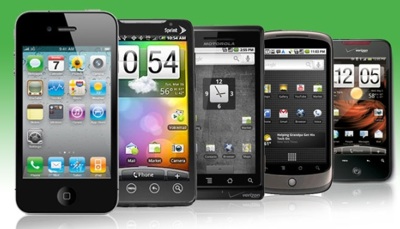
But more important for luxury brands, the iPhone and, three years later, the iPad completely changed the way consumers engage with brands and content online, says Tom O’Regan of chief revenue officer of New York-based Martini Media. Thanks to smartphones and tablets, consumers no longer need to be in front of a computer or in a store to engage with a brand or retailer.
You need to be wherever your customer is, said panelists in a recent webinar sponsored by Luxury Daily and titled “What Apple’s Offense Means To Luxury Brands, Retailers, and Rivals.”
“Luxury brands must have a presence on iOS (Apple) devices,” says Jack Philbin, president and CEO of Chicago-based Vibes, a mobile media company. “Think of it as an efficient gathering of your target market.”
“Before iPhones and iPads, there was no canvas for luxury marketers to reach their customers everywhere,” said Patrick Frend, managing director of Razorfish. “Now people’s information is independent of device—they carry the relationship you’ve built across all these devices.” Apps and iTunes have lowered the barriers to get brand experiences directly into the hands of consumers, he said.
O’Regan says these devices have very quickly become part of the American lifestyle.
“The single biggest innovation Apple has been able to accomplish is to give consumers a way to consume content on the go. It started with music, but it has extended into all forms of media. We're seeing a huge shift in the type of advertising creative being produced—more than ever, it's being designed for tablets and mobile devices, where we see more and more consumption of media. With half of all affluent consumers, our primary target audience, living in a household with at least one tablet, this new way of accessing media is bound to become a mainstay across all audiences.”
Philbin added, “Apple has done a great job rethinking retail. They have enabled luxury marketers to have a better relationship with their customers through iOS devices. [They do] a great job at seeing where a market has gotten too far away from what a luxury consumer wants, and do a great job simplifying and delivering on those needs.”
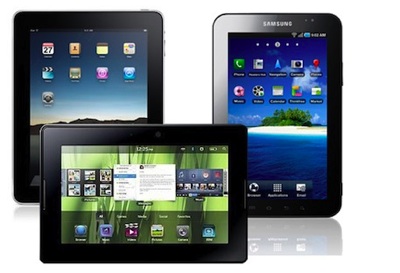
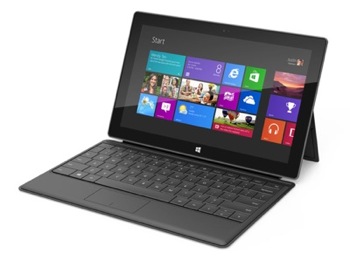
Like the iPhone before it, the iPad (left rear) set the tone for tablet design. Even Microsoft's new Surface, right, mimcs the iPad's sleekness. But the tablet changed the marketing game because consumers no longer need to be at a computer or in a store to have a brand experience.
Apple as game-changing market disruptor. But the other critical thing Apple did was to focus on the experience of using technology, not just whether its processors are faster than any others. Yes, its devices do lots of things we didn’t even know we wanted to do—but so do PC’s, and they cost a lot less. But Apple’s devices offer an easier, more fun, and way cooler-looking path to do those things, as well as a consistent, seamless user experience across all their devices. The focus on experience has created such an intense loyalty among Apple customers that they not only willingly spend three or four times more to own an Apple device than a competitor’s device, they also buy multiple products in the line even if they seemingly duplicate functions. It’s luxury, yet it remains accessible.
Luxury jewelers can certainly lavish up the shopping experience, but what options exist to become a game-changer?
The jewelry industry is no stranger to market disruption. First it was catalog showrooms; then it was TV shopping. But those primarily impacted the middle market; the next disruptor, the Internet, overturned the apple cart for everybody. Even luxury jewelers’ customers came brandishing Rap sheets and Blue Nile printouts, whittling diamond margins to razor-thin.
But the very same thing that turned the world upside-down also presents new opportunities. Social media, combined with ubiquitous connectivity, gives jewelers a cost-effective means of bringing their in-store experience online and gaining new fans to become customers. They can emulate Apple by focusing on the experience of searching for, buying, owning, and wearing the diamond, rather than the diamond itself.
There may be something else in the wind as well. Dr. Jem Bendell, PhD, a business professor in Australia and the United Kingdom, believes sustainability is the up and coming game-changer that will disrupt the luxury marketplace. In a white paper, he describes how the Tesla Roadster (which debuted in 2006 for $98,000) changed the game for electric cars. The Roadster plugs into an ordinary wall socket but can go from zero to 60 in four seconds, elevating the category from puttering nerd-mobiles to fast and cool, and inspiring other luxury carmakers like Rolls Royce to try an electric vehicle.
For jewelers, this can mean a case of jewelry made by economically disadvantaged workers, such as MJ Christensen and its Beads For Life, or highlighting the good that comes from diamonds, such as schools in South Africa and Botswana who receive monies from the Diamond Empowerment Fund.
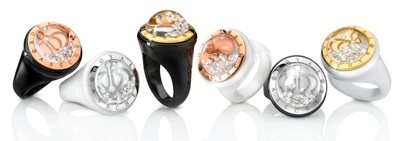
A portion of sales from these Stars of Africa rings by Royal Asscher benefit the Diamond Empowerment Fund.
Bendell believes luxury consumers will seek differentiation by focusing on the provenance and production of an item as much as the item itself. Luxury companies need to respond by providing greater, more transparent product information, elevating the consumer from acquirer to social steward.
Apple logo image: www.creativebits.org







